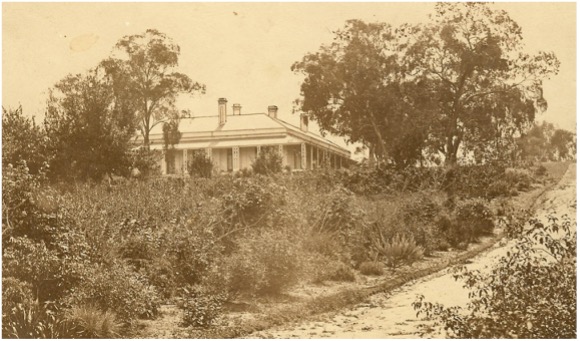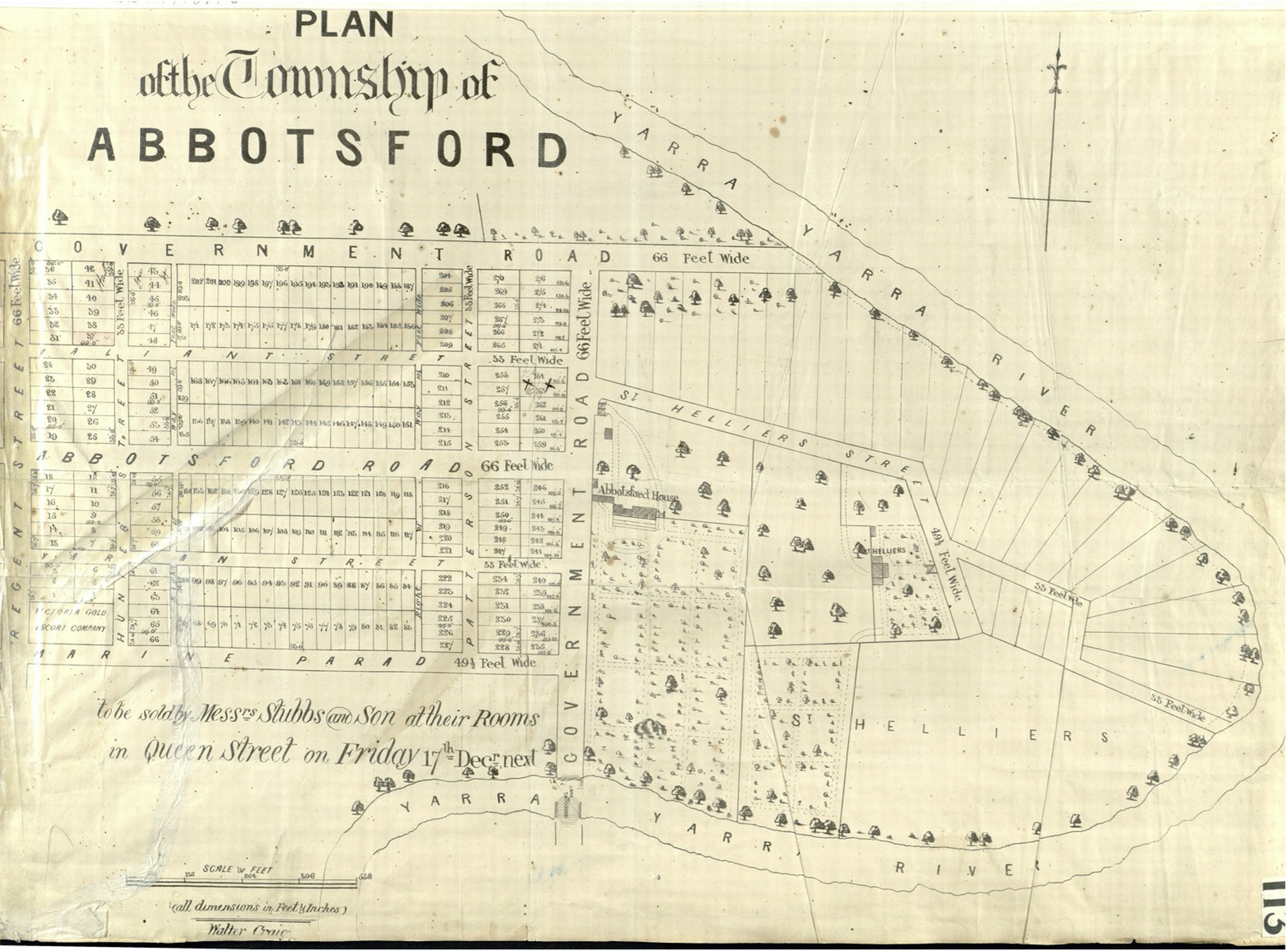Collingwood Notables Database
John Orr
c. 1816 - 1860
Early settler, merchant, Melbourne councillor, subdivider
To John Orr goes the honour of originating the name Abbotsford for the eastern section of Collingwood. In the 1840s he acquired an extensive landholding near the Yarra River and built Abbotsford House, assumed to have been named after the home of the popular Scottish novelist Walter Scott. When Orr began subdividing his property in the 1850s, the allotments were referred to as ‘The Abbotsford Estate’, or ‘The New Town of Abbotsford’ and this name was later assigned firstly to the electoral division and eventually to the whole of the area of Collingwood east of Hoddle Street. A nineteenth century photograph shows his house as a substantial gentleman’s dwelling with a veranda on three sides and a well-stocked garden running down to the Yarra. Within a few years he would die a hopeless alcoholic, living out his last days in a small hotel room.
After arriving in Australia from Glasgow late in 1839, Orr quickly established himself as a merchant and shipping agent with an office and warehouses in Flinders Street. He was a partner in a company called Turnbull Orr and Co. but this ran into difficulties in 1846, and he reorganised his business under the name John Orr and Co. He was elected an Alderman in the first Melbourne Council elections in 1842 and remained a councillor until 1846.
In 1841 Orr married Tasmanian-born Mary Hudspeth; four children would be born to the couple. Two noted diarists who were their neighbours, Georgiana McCrae in the 1840s and Emily Childers in the 1850s, refer in their journals to visiting them. The 1840s and early 1850s would seem to have been an idyllic and prosperous period. Orr was successful in his business and a respected member of the small population of Melbourne, while home was set in a semi-rural retreat in the picturesque curve of the Yarra River. The household in the early 1840s was described by visitors: ‘The style of living was decidedly liberal, everything was in abundance, champagne galore’. John’s brother Matthew who emigrated in early 1843 lived with the couple for some time, as did a Major Davidson and family whose retinue of ten Indian servants camped in the garden and delighted the McCrae boys with their exotic dress, tents, hubble-bubble pipes and strongly scented curries.
The extensive grounds of the house were soon established as gardens, which were not only ornamental but also productive. As soon as the Victoria Horticultural Society was established in 1850, Orr began entering his produce. His first attempt was with Sweet Water apples and a variety of grapes. He won prizes for his potatoes, stone pippin apples, strawberries, and apricots. Neighbours were frequent recipients of this bounty, while multi-acre allotments were planted to potatoes and oaten hay, and these were advertised for sale. A sadder note was struck in 1851 with the death of daughter Mary Jane around the age of five. However, when in the mid-1850s Hugh and Emily Childers were renting the neighbouring house, St Heliers, from Mrs Curr, Emily’s diaries indicate the extensive social life enjoyed by Mrs Mary Orr, with frequent visits and outings including a fishing party in the Orrs’ boat. Mary’s sister Catherine Clarke was a regular visitor, and Mrs Degraves who lived at nearby Campbellfield was a good friend. Emily did also note that Mr Orr was ‘very tipsy’ on occasion.
Orr owned not only his mansion, plus land on the north side of St Heliers Street with a four-roomed brick house facing the Yarra, but also a large expanse of land bounded by Clarke, Johnston, Nicholson (then Regent Street) and Gipps Streets. In 1852 he initiated the process of surveying and subdividing this tract and the first auction of his land, handled by Stubbs and Son, was held in December 1852. Despite the burgeoning population of Melbourne following the gold rush, sales were very slow. A second auction was planned in 1856 by agent W M Tennent.
In 1855 Orr added an extensive structure. As well as his subdivisions, he suddenly advertised his own house for private sale or to let in May 1855.
The Mansion House, Gardens and Grounds … extend over eight acres, and are in a state of high cultivation The recent additions to the buildings … an eligible opportunity for the establishment of a public hospital or benevolent institution; while they do not in the least interfere with the privacy and comfort of the mansion house itself.
Nobody seemed to want it, and in the meantime, he was busy with the committee for the Johnston Street Bridge as well as standing (unsuccessfully) for the Legislative Assembly in Alberton, Gippsland, where he owned land. In September 1856 he advertised again, this time to let, suggesting it could be suitable for a hotel or similar business.
In November 1856, there was a massive ceremonial opening of the long-awaited bridge which was expected to bring significant commercial advantage to the district. About 5000 people attended, with a heavy preponderance of Masonic members. A select group then set out for Abbotsford House for refreshments in:
… one of the large halls of the building placed at the disposal of the committee by John Orr, Esq., the proprietor. The hall was tastefully decorated with the flags of all nations, with evergreens, and flowers. Three lines of tables were set out throughout the full length of the room, with a cross table, at which those who took a prominent part in the proceedings were seated. T. T. A'Beckett, Esq., the Chairman of the Municipality presided; Mr Orr being in the Vice chair. Behind [them] was an excellent drawing of the bridge ... The tables were well laid out and plentifully supplied … The wines being in abundance and of good quality.
The auction by W M Tennent for the remaining unsold lots had been deferred until after the bridge opening, and took place the following week. It is not clear whether Orr was in difficult financial straits during the sales of his subdivided land, or was attempting to realise some capital from his property with another proposition in mind. From mid 1854 there is no longer any evidence of his acting as a freighting agent. What is certain is that the mid-1850s saw the idyll turn to disaster. Emily Childers had noted in her diary in mid-1856: ‘Mrs O, poor thing, is said to be in a decline’. She was referring to the nineteenth century scourge of tuberculosis, then known as consumption or phthisis. While often slow-acting, it was commonly fatal. So while Mary Orr continued to be involved in social activities including what Emily described in October 1856 as a ‘very large and very good party at Mrs Orr’s – quite a public affair, danced a good deal’ she died in August 1857 in a Woolloomooloo boarding house and was buried in Sydney, to be followed to the grave not long afterwards by her sister. In the same year Orr was declared insolvent and trustees took over the sale of Abbotsford, his city property, and the remaining unsold lots at unreserved prices, managing to pay out 6s 8d in the pound by February 1858. To make matters worse, those years of free-flowing wine and champagne had taken their toll.
Abbotsford House became for several years the residence of bank manager Frederick Cook. There is some indication that Orr stayed with his wife’s brother-in-law Clarke in Robe Street St Kilda, then lived in Nicholson Street Fitzroy. Shortly before his death at the age of 44 he had an argument with his landlady and a friend installed him in the Brunswick Hotel in Fitzroy, but later found him dead. The immediate cause of death was given as an effusion of blood on the brain. The autopsy report on his emaciated body and the condition of most of his internal organs including lungs, brain, heart, stomach, spleen and kidneys make for horrifying reading. The presence of tubercles on his lungs suggests that he had succumbed to his wife’s tuberculosis, while several doctors confirmed that they had previously treated him for alcoholism and delirium tremens.
He had gone from a successful merchant with a large and beautiful property to a semi-homeless man whose probate was valued at less than £50. Where his teenaged sons were around those years may remain a mystery. They perhaps went to live with relatives, as they turn up in adulthood in Ballarat. James and William became bank managers in Victorian provincial towns, while John settled in Maitland, NSW.
In 1863, a group of Good Shepherd nuns arrived in Melbourne in search of a large house suitable for an asylum for women in need. On inspecting Abbotsford House, Mother Mary of St Joseph wrote:
… the dwelling house was large and handsome with fine lofty rooms and veranda all round and a tempting garden by the Yarra’s banks, with fine fruit trees, peaches, pears, apricots, apples, lemons, grapes and mulberry trees, under which were violets growing so profusely that the air was scented.
The nuns not only acquired a haven of tranquillity, and a source of wholesome food, but at last Orr’s additions would be put to advantageous use. The house was eventually demolished around the end of the nineteenth century and the large three-storey convent building still on the site was constructed.
Subdivision 1852
Life Summary
| Birth Date | Birth Place |
|---|---|
| Ca. 1816 | Glasgow |
| Spouse Name | Date of Marriage | Children |
|---|---|---|
| Mary Hudspeth | 1841, Collingwood | John 1842-1890, James 1844 -1900, Mary Jane 1845-51, William 1846-. |
| Home Street | Home City | Status of Building |
|---|---|---|
| Clarke Street | Abbotsford | Demolished |
| Church | Lodge |
|---|---|
| Presbyterian |
| Death Date | Death Place | Cemetery |
|---|---|---|
| 17 February 1860 | Fitzroy | Melbourne General Cemetery |
The Argus, The Age, Collingwood Conservation Study; Barrett, The civic frontier; Uhl, A woman of importance; McCrae, Georgiana’s journal; Niall, Georgiana;
Cummings, Bitter roots, sweet fruit; Cummings, Streets, parks and lanes of Collingwood; Otto, Yarra.
VPRS 24 P0 Unit 78 1860/152, Inquest, John Orr
Trove list ‘John Orr’ https://trove.nla.gov.au/list/82452
Trove list ‘Orr children’ https://trove.nla.gov.au/list/82417
Trove list ‘Abbotsford Estate’ https://trove.nla.gov.au/list/72895
Trove list ‘Abbotsford House’ https://trove.nla.gov.au/list/50259
Stubbs auction plan 1852 http://handle.slv.vic.gov.au/10381/166768
Easey auction plan 1857 http://handle.slv.vic.gov.au/10381/161531
Easey auction plan riverside lots 1857 http://handle.slv.vic.gov.au/10381/282164
Unsold riverside allotments 1858 http://handle.slv.vic.gov.au/10381/161637
Streets and buildings in East Collingwood 1 January 1858 http://handle.slv.vic.gov.au/10381/117381


